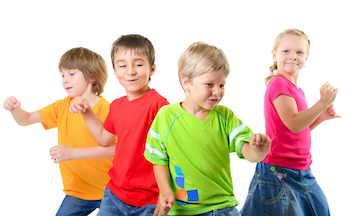SUBJECTS
GRADE
Show Results
Miniature Golf

Lesson Summary
- Create geometric shapes with the body.
- Move shapes around using prepositions.
Lesson Plan and Procedure
Lesson Key Facts
- Grade(s): 2
- Subject(s): Dance, Math
- Duration of lesson: 30 minutes
- Author(s): Jana Shumway
Note: This lesson may be used as a child’s first exposure to geometric shapes if you provide a picture to accompany the challenges.
Experience/Identify
Have children think of different miniature golf courses they have visited and played at.
Teacher: What are some of your favorite golf courses like? Some courses contain hills or bumps, ramps or bridges, windmills or castles, but whatever the obstacle, the course will have a challenging way for the golf ball to get into the hole.
Show some images of miniature golf courses to spark their imaginations.
Explore/Investigate 
Play “Marakesh” by Tangerine Dream. Repeat the song as necessary.
Have nine holes set up on the “course” (in a circle around the gym/room). Divide the children into groups of two or three. Do not exceed 10 groups.
At each number, have the students design a geometric shape with a plan of how the prepositional challenge will work with the ball. For example, at the first hole, students will go under the trapezoid.
Each hole should have a paper that explains the children’s two challenges (see below).
| Hole | Preposition | Geometric Shape |
|---|---|---|
| Hole 1 | Under | Trapezoid |
| Hole 2 | Behind | Pyramid |
| Hole 3 | Through | Circle |
| Hole 4 | On | Square |
| Hole 5 | Around | Cylinder |
| Hole 6 | Down | Triangle |
| Hole 7 | Beside | Cone |
| Hole 8 | Over | Sphere |
| Hole 9 | Inside | Cube |
As the children finish their geometric shapes, they can identify their shape in a larger image or object, such as a castle or a mountain.
Remind students that non-locomotor movements are shapes that are not moving (golf shapes). The locomotor shapes are ones that are moving (ball).
Once the children have created their first miniature golf course, the tenth group of children who did not create a shape will represent the “ball.” Tee off those children and watch them go under, behind, through, on, around, down, beside, and over the entire course, in order, from holes one through nine until they get trapped inside the cube at hole nine.
The children do not need to get on top of another child on hole four. Remind them that the word on can be represented by just one body part.
Have the children rotate to the next higher number, ready to create course two. Continue through and create 10 different golf courses.
Note: The children do not get tired of this activity because there is always a new objective to meet. In fact, they often get more creative as time goes on.
Connect/Analyze
Have the children reflect and identify which objects represent which geometric shapes. Quiz them on the names of the geometric shapes with images.
Ask them the meaning of a preposition. (Answer: A word that expresses a relation to another word or element.)
Have them list some of the prepositions that the ball in their golf course performed.
Learning Objectives
- Recognize shapes by their specific attributes.
- Identify several advanced geometric shapes.
- Explore shapes that are inspired by a stimulus.
- Demonstrate pathways with a clear focus and intent.
Utah State Board of Education Standards
This lesson can be used to meet standards in many grades and subject areas. We will highlight one grade’s standards to give an example of application.
Grade 2 Math
- Strand: Geometry (2.G) Reason with shapes and their attributes.
- Standard 2.G.1: Recognize and draw shapes having specified attributes, such as a given number of angles or a given number of equal faces. Sizes are compared directly or visually, not compared by measuring. Identify triangles, quadrilaterals, pentagons, hexagons, and cubes.
Grade 2 Dance
- Standard 2.D.CR.2: Explore movement inspired by a variety of stimuli.
- Standard 2.D.P.4: Demonstrate clear pathways and intent when performing locomotor and non-locomotor movements.
Equipment and Materials Needed
- Nine signs indicating the hole number, the preposition, and the geometric shape
- Music track: “Marakesh” by Tangerine Dream
Additional Resources
ignore
Image References
Image 1: Shutterstock (https://www.shutterstock.com/image-photo/smiling-girls-all-holding-each-others-335302247).
Image 2: 123RF (https://www.123rf.com/stock-photo/children_dancing.html?mediapopup=20672844).
Image 3: Shutterstock (https://www.shutterstock.com/image-photo/group-school-aged-kids-backpacks-107834846?src=CHbPZopCAiCfJQ1SWVtcgg-2-14).

www.education.byu.edu/arts/lessons
 Download
Download